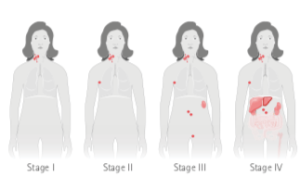
Lymphoma is a type of blood cancer involving the lymphatic tissues where the normal lymphocytes become cancerous. The type of lymphocyte and at which stage of the lymphocyte life cycle determines the type of lymphoma. The two main groups are Hodgkin Lymphoma (HL) and Non-Hodgkin’s Lymphoma (NHL). Most Hodgkin Lymphoma (> 95%) are fall into the category of classical Hodgkin Lymphoma and this information leaflet refers only to this most common type.
Accurate diagnosis of the exact type of lymphoma is the most important first step to receive effective treatment.
The reason why some patients develop lymphoma and others don’t, is not clear. However, several factors are known to be associated with the development of lymphoma. These factors include viruses like HIV (Human Immunodeficiency Virus)and Epstein Barr Virus (EBV). Other possible factors include environmental carcinogens and certain rare genetic disorders.
While Hodgkin Lymphomas can present with a large variety of symptoms, the common symptoms are:
Having these symptoms does not mean that someone has lymphoma. In fact, most times these symptoms are not due to cancer. However, anyone with such symptoms should see a doctor to be diagnosed appropriately and treated if needed.
 How is Diagnosis made?
How is Diagnosis made?
A biopsy of the affected lymph glands is essential for the diagnosis of lymphoma. This can be in the form of an incision biopsy (small piece of lymph node tissue) or excision biopsy (removal of one entire lymph node). Fine needle aspiration alone (where a needle is inserted into the affected lymph gland to draw cells out for examination) should not be used for diagnosing lymphoma. The biopsy tissue obtained is subjected to special stains that allow accurate classification of the lymphoma type.
Once the diagnosis of Hodgkin Lymphoma is confirmed, a staging assessment has to be done. Staging refers to the extent of the lymphoma in the body. This often carries prognostic significance and is very useful to help develop treatment plans for the patient. There are 4 stages (Stage I to IV) as well as a A or B category. The various stages are as follows:
Staging involves imaging with PET-CT or CT-scans. Depending on the scenario, further tests like bone marrow biopsy may be carried out.
Treatment may involve any of the following modalities, chemotherapy, radiotherapy, immunotherapy and stem cell transplant. Very often, it is likely a combination of 2 or more of the above modalities. This is dependent on the subtype of lymphoma and various prognostic features of the lymphoma.

Chemotherapy drugs are also known as cytotoxics represent the main treatment of someone with newly diagnosed Hodgkin Lymphoma. In general, these drugs kill cells that rapidly divide/ grow. Thus, cytotoxics are highly effective for killing cancer cells but will also damage normal cells of the body which dividerapidly like the hair follicles and normal blood-forming cells in the bone marrow. These effects manifests as hair loss and temporary declines in blood cells (like red blood cells, white blood cells, platelets). Chemotherapy may also be combined with monoclonal antibody therapy in certainnewly diagnosed patients.
Immunotherapy is treatment that uses the patient’s own immune system, or medications made from components of the immune system, to fight the disease. There are many forms of immunotherapy. In the case of Hodgkin Lymphoma, the main form ones are monoclonal antibodies that target a specific protein on the Hodgkin Lymphoma cancer cell and, injections known as checkpoint inhibitors. These treatments are highly effective in killing Hodgkin Lymphoma cells but are usually used as second-line treatment.
A person with recurrent Hodgkin Lymphoma may receive stem cell transplantation, usually as second-line treatment. A transplant of blood-forming stem cell allows a person to receive high doses of chemotherapy, radiation therapy, or both. The high doses destroy both lymphoma cells and healthy blood cells in the bone marrow. Later, the patient receives healthy blood-forming stem cells through a flexible tube placed in a large vein in the neck or chest area. New blood cells develop from the transplanted stem cells.
Stem cell transplants take place in the hospital. The stem cells may come from the patient’s own self or from a healthy donor.
Radiation therapy (also called radiotherapy) uses high-energy rays to kill Hodgkin Lymphoma cells. It can shrink tumours and help control pain. Radiation is sometimes used in the first-line therapy in patients who have very large lymph node massesat presentation.

CanHOPE provides:
The CanHOPE team will journey with patients to provide support and personalised care, as they strive to share a little hope with every person encountered.
By clicking ‘Subscribe’, I consent to Parkway Cancer Centre, its employees, representatives, agents and/or business partners, collecting, using and disclosing my personal data for the following purposes and understand that I may opt out of the subscription at any time:
Events updates and invitations
E – newsletter
Other marketing and promotional purposes
*Please read our Privacy Policy for information on how we manage your personal data.
By clicking ‘Subscribe’, I consent to Parkway Cancer Centre, its employees, representatives, agents and/or business partners, collecting, using and disclosing my personal data for the following purposes and understand that I may opt out of the subscription at any time:
Events updates and invitations
E – newsletter
Other marketing and promotional purposes
*Please read our Privacy Policy for information on how we manage your personal data.